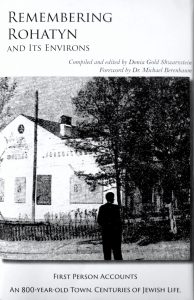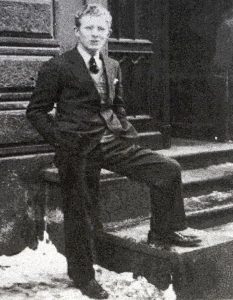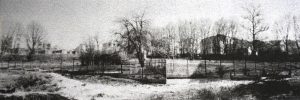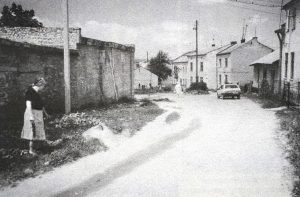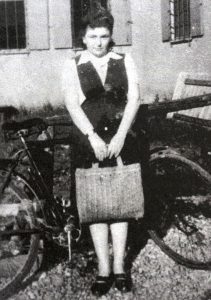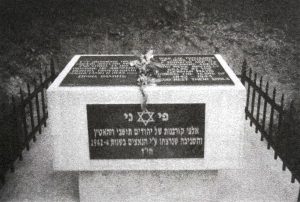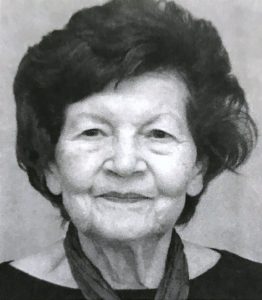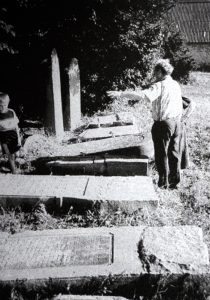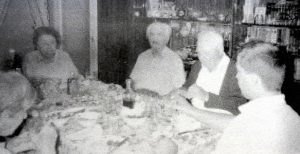![]() Ця сторінка також доступна українською.
Ця сторінка також доступна українською.
Donia Gold Shwarzstein; Remembering Rohatyn and Its Environs; Meyer Shwarzstein, publisher; 2019.
Introduction
[T]he town will spring to life through images of photos yet to be retrieved, through tales yet to be retold, through letters and diaries yet to be brought out of private drawers, through archives yet to be researched, through poems yet to be made known and read…
The passage above is from “Rohatyn in the Mirror of Memory”, one of several essays written by Donia Gold Shwarzstein for the collection she compiled and edited, Remembering Rohatyn and Its Environs. Herself a survivor of the Shoah in Rohatyn, in the essay Donia reflects on the effort she and many others made during the decades after the war to recover and reassemble memories of the Rohatyn they remembered, both at a distance and while standing in the much-changed town. The core of the text is an updated English translation of the Rohatyn Yizkor Book, supplemented by more than twenty additional essays, speeches, plus photographs from commemorative events and meetings, over 25 biographies of essay authors, plus a glossary of terms, a one-page timeline of World War II and the Holocaust in Rohatyn, and an index to named individuals and places in the text. Nearly 200 black-and-white photographs illustrate the text.
Donia published an earlier version of the book under a pseudonym (Leah Zahav) in 2015. For this edition, in addition to releasing the material under her own name, Donia worked with her son Meyer Shwarzstein to add new supplemental material and an expanded section on author biographies and post-war meetings of survivors and descendants. This new edition was published by Meyer shortly before Donia’s passing in June 2019. The book is available in hardback form from many global online booksellers, including Book Depository, AbeBooks US and UK, and others, as well as independent booksellers in the US, Europe, and beyond. The second edition should appear in libraries on the WorldCat system soon as well.
This page includes an outline of the book’s organization, a brief synopsis of Donia’s life as outlined by her son and supplemented in her essays, a summary of how the text may be useful to Rohatyn studies and other themes, and a few references to additional materials related to the text. Except where noted, all images here are from Remembering Rohatyn.
Organization of the Text
The text consists of an introductory section (with six essays), a large Part I (the entire Rohatyn Yizkor Book, in revised English translation), and a supplemental Part II which Donia compiled especially for Remembering Rohatyn.
In the introductory section, there is a map of the Rohatyn district (a political unit similar to a county) as it existed in 1939 at the start of World War II, and a street map of Rohatyn drawn in 1943 (under German occupation), acquired by Donia on one of her visits to Rohatyn after Ukraine’s independence from the Soviet Union. These are followed by a Foreword written by Dr. Michael Berenbaum, a noted Holocaust scholar and former project director of the United States Holocaust Memorial Museum. In his remarks, Berenbaum outlines the history of Rohatyn as a partly Jewish settlement and the destruction of its Jewish community; he also considers the displacing sensation of returning to a former home, now dramatically changed, and evokes “the Presence of Absence and the Absence of Presence”.
The introduction continues with a Preface by Donia in which she explains her motivations for compiling the book, and describes her working relationship with the Society of Rohatiner in Israel in the 1990s which led to the English translations and assembly of the essays which form the book. This is followed by a page of acknowledgments and others which outline the book’s sections as well as the research and decisions made to accurately translate not only the descriptive texts but also the names of people and places, always complex in this multicultural part of the world. Donia continues with a tribute to the Rohatyn Jews who saved her from death during the March 20, 1942 aktion which killed most of the Rohatyn Jewish community, an overview of the several Jewish social societies of Rohatyn émigrés, survivors, and descendants, and a copy of the society letter which authorized her to proceed with the revision to English translations and inclusion of additional material to create what Donia describes as “this expanded Yizkor Book”.
The core of the book is the entire contents of the Rohatyn Yizkor Book, which we have summarized with historical context on another page of this website. The Yizkor Book was originally written primarily in a mixture of Hebrew and Yiddish and published in Israel in 1962. Donia subsequently supervised a complete English translation of the Yizkor Book, three pages at a time, and compiled the full new version with editorial assistance from Michael J. Bohnen. At the suggestion of donors who supported the translation work, Donia then licensed the English version to JewishGen for free online access in 2001.
For Remembering Rohatyn, Donia reviewed and revised the full English translation, making corrections to personal names, place names, dates, and other details based on her own study as well as recent research by members of the Rohatyn District Research Group (RDRG) and others. As we note on the summary page for the Yizkor Book, it comprises more than 80 articles by almost 60 authors, including authors who would later write and publish their own book-length personal memoirs of life in Rohatyn (several of which are summarized on this website). Remembering Rohatyn also incorporates the 150-plus photos and illustrations from the original print Yizkor Book, putting faces to names and giving a sense of place to the Rohatyn the survivors remembered. The Rohatyn Yizkor book also remembers pre-war Jewish communities in seven nearby towns and villages which have no book-length memory book of their own, and Remembering Rohatyn likewise includes these “and environs” essays. The core text concludes with a list of known Jewish martyrs of the Holocaust in Rohatyn.
Part II of the book combines essays and records of events which occurred after the 1962 publication of the original Yizkor Book. Prominent among these materials, which cover over 100 pages, are speeches from and reflections on the memorial events in Rohatyn in 1998, and the related visits to establish new memorial monuments at the Jewish burial sites in town (cemeteries and mass graves). Donia herself contributed eight pieces to this section, but also gathered, translated, and edited a further dozen pieces from a variety of authors, primarily those who were prominent in organizing and managing the 1998 events. Many of these authors are still remembered by citizens of Rohatyn who attended the memorial events in 1998.
This section also includes an expanded collection of biographical sketches of the Yizkor Book contributors, either as autobiographies, or written by others, including by Donia herself.
In addition to a few supplemental photos of Yizkor Book authors within the biography section, an Appendix at the end of Part II includes a large number of photographs from the 1998 memorial events and from gatherings of Rohatyners in the US. An 18-page Glossary is also included, with many Hebrew, Yiddish, Polish, Ukrainian, and German terms relevant to Rohatyn and its several historical cultures explained for English-speaking readers. Finally, and index of names recorded in the text is included at the end.
A Brief Summary of the Editor’s Life
Dora (“Donia”) Gold was born in 1932, and grew up on the outskirts of Rohatyn; she was 8 years old when the German Army first entered Rohatyn, and 11 years old when the German occupation of the city ended. In between, she survived what her son calls “a series of tragedies and miracles”; she escaped the March 20, 1942 roundup and executions only by pretending to be the young daughter of her uncle, one of ten doctors who were spared in the first killings. An only child, she was orphaned by the Holocaust, in which she lost both of her parents and all four grandparents; by the war’s end, of her entire extended family she had only one uncle who had emigrated to Mandatory Palestine.
Donia emigrated to the United States in 1950, traveling via New York City to settle in Detroit. In 1955 she married Julius Shwarzstein, and had a son Meyer and a daughter Rena in the following years.
In the 1970s, Donia began organizing and speaking on behalf of Shoah survivors, prompted by the efforts of the National Socialist Party of America to march in Skokie, a suburb of Chicago where one in six residents had survived the Holocaust. Then in the 1980s, this effort grew and she became a founding member of the Holocaust Memorial Foundation of Illinois, now the Illinois Holocaust Museum and Information Center, where she also managed and led oral history and documentation projects, interviewing other survivors and American liberators. In 1987, Donia organized a first Child Survivor Conference in Pennsylvania, and in the 1990s she coordinated reunions for Jewish former refugees who had been housed at the Düppel Center UNRRA displaced persons camp at Berlin-Schlachtensee.
Donia moved to New York in 1984 and joined the Rohatyn Society, with whom she worked to create the English version of the Rohatyn Yizkor Book, and to organize new memorial monuments at the Jewish mass grave sites in Rohatyn in 1998. She also conducted new historical and biographical research, and compiled correspondence and other records for the expanded version of the Yizkor Book which became Remembering Rohatyn, in what Donia called a tribute to her Jewish rescuers of the war years.
Elements of the Text with Value to Rohatyn Studies
Remembering Rohatyn is probably the single most important and comprehensive text for the study of Jewish Rohatyn. Critical praise from pre-publication reviews by four people closely associated with Jewish Rohatyn and Holocaust studies appears on the back panel of the dust jacket: Father Patrick Desbois, founder and head of Yahad – In Unum; Michael Berenbaum, Director of the Sigi Ziering Institute and Professor of Jewish Studies at American Jewish University; Marla Raucher Osborn, co-founder and CEO of Rohatyn Jewish Heritage, focused on the history and heritage of Jewish Rohatyn; and Alex Feller, founder and leader of the Rohatyn District Research Group (RDRG), focused on research on the Jewish family history of Rohatyn and its diaspora.
In addition to improvements to the first English translation, and corrections of event dates based on later research, Remembering Rohatyn also adds considerable historical and memorial material to the original Yizkor Book, copies of post-war records, and explanations of how the diasporic Rohatyn Jewish community worked to remember their families and neighbors after the war. This effort created a very significant foundation for the work of the Rohatyn District Research Group (in family history, local history, and Holocaust research) and the work of Rohatyn Jewish Heritage (in its projects to rehabilitate Jewish physical heritage and reconnect the multicultural communities of Rohatyn). Remembering Rohatyn has served as an important reference for other researchers as well, including the professional forensic archaeologists of Staffordshire University ahead of their non-invasive survey of Rohatyn’s mass grave sites, as well as regional history-based tour companies with a focus on Jewish Galicia.

Donia with her son Meyer, Alex Feller, and Marla, studying a wartime aerial photo of Rohatyn
at an international Jewish genealogy conference in Los Angeles in 2010. Photo © 2010 RJH.
The several available published personal memoirs of Jewish life in Rohatyn (and its wartime ghetto) each provide greater detail about specific families and events, and complement the more extensive Remembering Rohatyn quite well. Ongoing research by others into particular aspects of Rohatyn’s Jewish past will naturally result in some more larger focused materials, such as the Shoah timeline on this website, which leverages information from the Yizkor Book, Remembering Rohatyn, individual personal memoirs, and many other sources. Combining resources may help other researchers as well, for example combining the names index in Remembering Rohatyn with the larger names index in the JewishGen online English translation of the Rohatyn Yizkor Book.
Additional References
Most of the information presented here is summarized directly from Remembering Rohatyn. As noted above, a summary of the Rohatyn Yizkor Book is also available on this website, as is a summary of the related Pinkas Hakehillot Polin encyclopedia of the Jewish communities of Poland’s article on Rohatyn. Summaries of individual personal memoirs of Jewish life in Rohatyn are also available here. We also present a series of historical timelines of Jewish Rohatyn, spanning the more than three centuries of community.
Donia’s years of work connecting and commemorating Holocaust survivors have also left traces in a variety of society publications, including the search column in the newsletter of The American Gathering of Jewish Holocaust Survivors and Their Descendants (2008, p. 22).
Biographical details about Donia were kindly provided by her son and publisher, Meyer Shwarzstein, in 2019. See his memorial remarks for his mother and for the Jews of Rohatyn deported and killed during Yom Kippur in 1942, on the blog site of The Times of Israel from October 4, 2019.
This page is part of a series on memoirs of Jewish life in Rohatyn, a component of our history of the Jewish community of Rohatyn.

